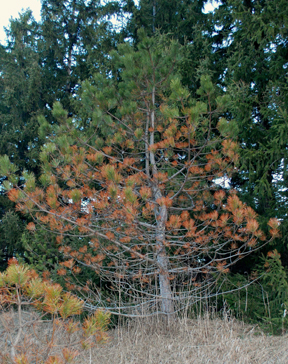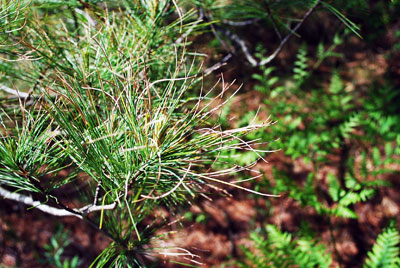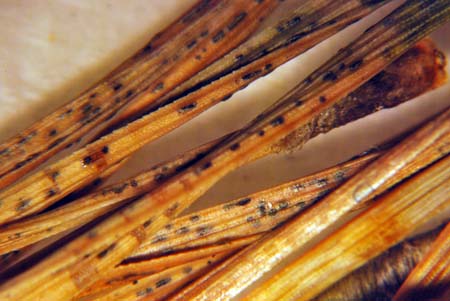Managing needle blights of pine
Dothistroma needle blight and brown spot needle blight need to be properly managed in pines. Recognize the symptoms and know how to control these diseases this summer.
Dothistroma needle blight
Dothistroma needle blight is caused by the fungus Mycosphaerella pini. This common pine pathogen kills needles of all ages and can weaken or kill Austrian pine trees. We are also finding Dothistrom on white pine. The main symptom is dead needle tips beyond the yellow to tan needle spots that enlarge to form distinct brown to reddish-brown bands.

Needle tips turning brown on Austrian pine.
Photo credit: Jill O’Donnell, MSUE

White pine from Dothistroma needle blight.
Photo credit: Jill O’Donnell, MSUE
The black fruiting bodies of the fungus can be seen in the dead spots or bands on the needles. The spores spread by wind and rain and can infect needles throughout the growing season. New needles are susceptible once they emerge from the needle sheaths. The black fruit bodies appear in the fall; however, the spores are released the following spring and summer.
The best protection of new needles can occur when applying copper-based materials as the new needles emerge from the needle sheaths and as the spores are released from the fruiting bodies. To protect foliage from infection, apply a registered fungicide containing copper in mid-June through mid-July. This year, you might start earlier since trees are ahead of normal. Repeat the application two or three times as needed at seven- to 10-day intervals.
Brown spot needle blight
Brown spot needle blight (Mycosphaerella dearnessii, syn. Scirrhia acicola) is relatively new to Scotch pine in Michigan. Needle spots can appear on needles at any time of the year, but most commonly we find them during August and September when the tree suddenly turns brown just before harvest.

Black fruiting bodies on dead needles.
Photo credit: Jan Byrne, MSU Diagnostic Services
Even though we see the symptoms in the fall, fungicide applications should be timed when the new needles are about half grown (May-June) and a second spray about three weeks later. In rainy conditions, the spray interval may need to be shortened. Several fungicide products with chlorothalonil, mancozeb or copper are labeled for control.
Growers will also want to adjust their shearing practices to avoid moving spores into other plantations.
- Do not shear infected trees during wet weather because spores released at this time may be carried from tree to tree on workers’ clothes or shearing tools.
- Sterilize tools after shearing affected plantations by dipping in denatured alcohol for three minutes.
- Shear healthy plantations first so pathogen spores will not be carried into them from affected plantations.
Dr. Fulbright's work is funded in part by MSU's AgBioResearch.



 Print
Print Email
Email

